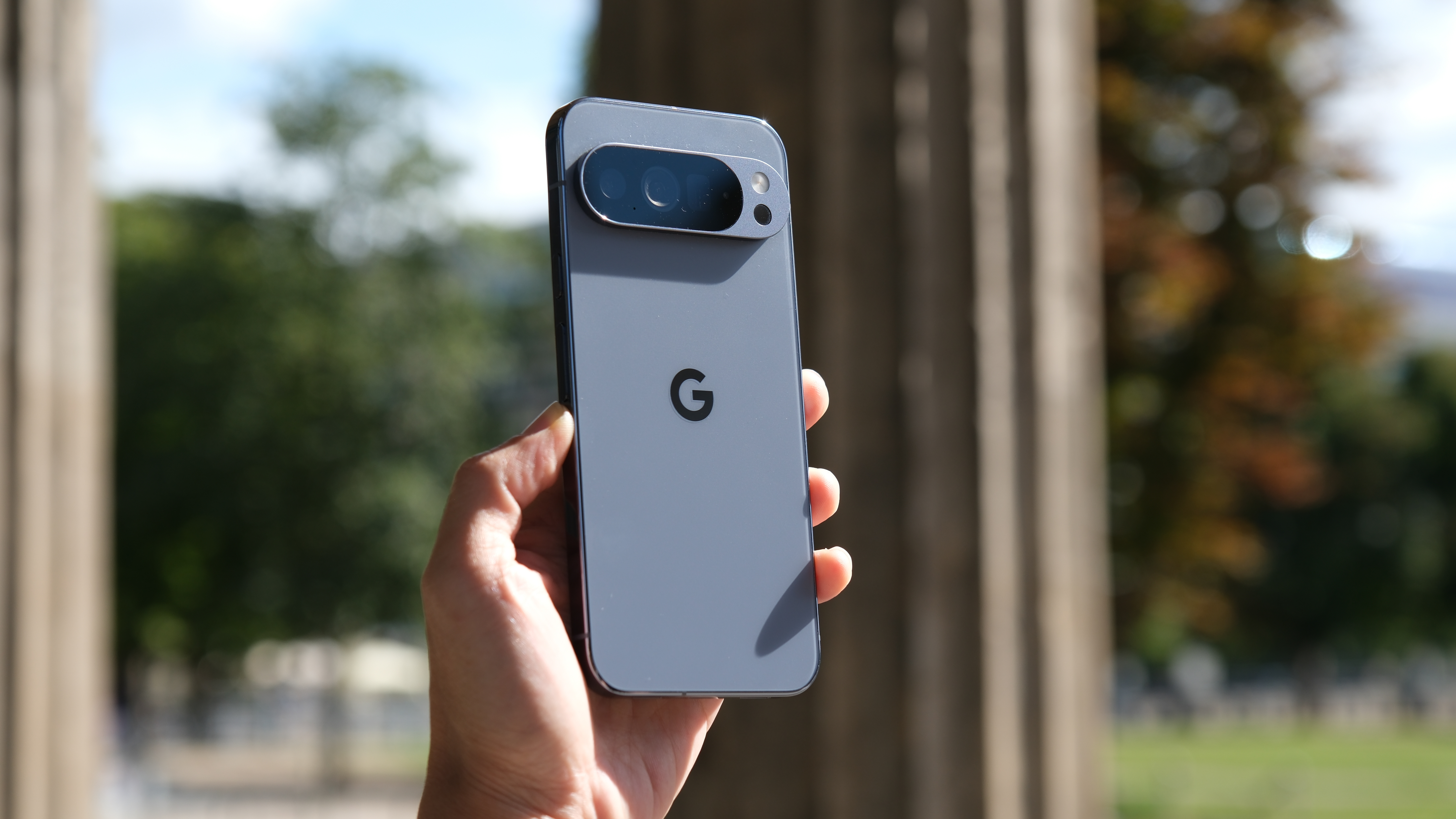By Gareth Bevan
Copyright digitalcameraworld

Skip to main content
Close main menu
Digital Camera World
THE HOME OF DIGITAL PHOTOGRAPHY
View Profile
Search Digital Camera World
Accessories
Buying Guides
The Photography & Video Show
Digital Camera
Australian Camera
Australian ProPhoto
Photography Magazines
Why subscribe?
Issues filled with product reviews, latest updates, expert advice and more
Delivered to your Android or IOS device
Every issue is packed with photo tips, kit reviews and inspiration
From$12Subscribe now
Camera news
Camera rumors
Photography & Video Show
Cheatsheets
Photo mag deals
Prime Day deals
Don’t miss these
Android Phones
The best Android phone for photography: smartphones that give Apple a run for its money
Android Phones
Google’s Pixel 10 thinks it can teach you to be a better photographer using AI
Android Phones
Nothing Phone (3) review: flagship phone, but not flagship cameras
Android Phones
The Pixel 10 Pro cameras are solid, but a Google Pixel “Ultra” would really change the mobile photography game
Android Phones
Sony Xperia 1 VII review: authentic photography or outdated technology?
Android Phones
Vivo V60 review: a mid‑range phone camera that goes the extra mile
Android Phones
Samsung Galaxy Z Fold 7 review: making up for lost time
Phone Cases
Wow! Here’s a oddly compelling reason to pick a Pixel 10 over an iPhone 17
Android Phones
Vivo X200 FE review: pocket-sized performer
Android Phones
Honor Magic V5 review: slim, light, and ready to rival Samsung
Android Phones
Oppo A5 5G review: A big battery but not much else
Android Phones
I don’t think most people should be buying flagship phones anymore
Best budget camera phones in 2025: the best cheap camera phones right now
Android Phones
From rigs to gimbals, the Pixel 10’s new PixelSnap magnets finally make it a content creation tool to rival the iPhone
It’s a Leica showdown! Can the Leica co-engineered Xiaomi 15 Ultra take on Leica’s own D-Lux 8 compact camera?
Android Phones
Google Pixel 10 Pro and Pro XL review: Android’s safe bet
Steady improvements and Android’s most reliable cameras make the Pixel 10 Pro a worthwhile update
Gareth Bevan
18 September 2025
When you purchase through links on our site, we may earn an affiliate commission. Here’s how it works.
(Image: © Gareth Bevan / Digital Camera World)
Digital Camera World Verdict
It might not have the spec sheet to upend the camera market, but the Pixel 10 Pro continues to do what Google does best – reliable camera performance time after time, now upgraded with more effective 100x super-res zoom, camera coach, and Google’s suite of AI editing tools. However, video is still a weak spot, with so-so quality and an over-reliance on AI upscaling. But the Pixel 10 Pro is beautifully designed, feels great in the hand, and the screen is stunning. In day-to-day tasks, Google’s latest Tensor chip doesn’t feel slower than the competition, and the battery just about holds up for all-day use. It might not be the most powerful camera phone money can buy, but for most people who want easy photos every day – the Pixel 10 Pro is likely the best option.
$34.73 at AT&T
$1,199 at Amazon
$1,199 at Visible
$1,199.99 at Verizon
Excellent camera performance on all three lenses
Super Actua screen is stunning
Premium design that feels great in the hand
Battery decent, but can’t keep up with rivals
Video lags behind competition
Best picks for you
The best Android phone for photography: smartphones that give Apple a run for its money
The best camera phone in 2025: what’s the best smartphone for photography?
The best phone for video recording and vlogging
Why you can trust Digital Camera World
Our expert reviewers spend hours testing and comparing products and services so you can choose the best for you. Find out how we test.
Specifications
Camera Performance
Phone Performance
Alternatives
In today’s flagship smartphone market, photography has become a key differentiator. Google’s Pixel smartphones have consistently been defined by their photographic capabilities, setting benchmarks for computational photography since the early days of the series. Over successive generations, features such as Night Sight, Super Res Zoom, and advanced portrait processing have made the Pixel line a gold-standard for mobile imaging.
The Pixel 10 Pro and Pro XL arrive as the latest entries in this lineage, positioned at the top of Google’s hardware portfolio. But with increasingly hot competition from rivals both in camera hardware and software smarts – can Google’s latest offerings do enough to cling onto the crown?
(Image credit: Gareth Bevan / Digital Camera World)
Google Pixel 10 Pro & Pro XL: Specifications
Swipe to scroll horizontally
Pro XL: 6.8in, 1344x2992px, ~486ppi, 120Hz, 3300nits (peak)
Pro: 6.3in, 1280x2856px, ~495ppi,120Hz, 3300nits (peak)
Google Tensor G5
256GB / 512GB / 1TB
Operating System
Main camera
50MP, f/1.7, 25mm, 1/1.31″, 1.2µm, OIS
Telephoto camera
48MP, f/2.8, 113mm (5x), 1/2.55″, OIS
Ultrawide camera
48MP, f/1.7, 123˚, 1/2.55″, AF
Front facing camera
42 MP, f/2.2, 17mm, AF
4K30/60fps, (8K30p cloud upscaling)
Battery & charging
Pro XL: 45W wired; 25W Qi2 wireless
Pro: 30W wired, 15W wireless
Pro XL: 232g / 8.18 oz
Pro: 207 g / 7.30 oz
Pro XL: 162.8 x 76.6 x 8.5mm / 6.41 x 3.02 x 0.33 in
Pro: 152.8 x 72 x 8.5 mm / 6.02 x 2.83 x 0.33 in
Google Pixel 10 Pro & Pro XL: Price
The Pixel 10 Pro starts again this year at $999/£999 for 128GB of storage – undercutting the base iPhone 17 Pro by $/£100. The base model Pixel 10 Pro XL, on the other hand, now starts at $1,199/£1,199 due to its 256GB of storage rather than last year’s rather paltry 128GB. This now places it at the exact same price as the iPhone 17 Pro Max.
While I am always grateful for additional storage, usually when the base model gets more storage, it is because the price of the parts has come down. It might have won Google a little more love to go with the consumer-friendly move to swallow the cost and stick to last year’s price. You can configure the phone with up to 1TB of storage for $1,549/£1,549 for the Pro XL and $1,149/£1,149 for the Pro, but I think for most people, 256GB is probably enough.
Does the Pixel 10 Pro justify its high price? This is not the old Pixel days of great cameras, but a compromised phone. The Pixel 10 Pro is the most premium phone Google has made yet. An all-round complete package, it looks and feels every bit as good as something coming from Samsung and Apple, both of whom you’d expect to be charging this sort of money.
Today’s best Google Pixel 10 Pro XL andGoogle Pixel 10 Pro deals
Google Pixel 10 Pro XL
$34.73View
See all prices
Google Pixel 10 Pro
$31.95View
See all prices
We check over 250 million products every day for the best prices
Google Pixel 10 Pro & Pro XL: Design
(Image credit: Gareth Bevan / Digital Camera World)
Google seems to have found its stride with its Pixel Pro designs. The Pixel 10 Pro and Pro XL look almost identical to last year’s models. Not that this is a bad thing. I think that the Pixel 10 Pro is a really good-looking phone. Yes, the divisive yet signature camera bar is still prominent on the back, again in a raised plateau rather than the bar merging with the sides of the device, but it’s a design that, from initially thinking it was a little wacky, is one I’ve grown to love – and it’s still a standout design from everything else on the market.
For colors, this year, the phones’ matte glass backs come in the usual Obsidian (black) and Porcelein (a slightly yellowish white) with color-matching polished silver side rails and camera bar. These regulars are joined by two new colors. Moonstone (which is the model I have for testing) is kind of grey, kind of blue, depending on the light, but it’s a really nice shade and my personal favorite. There is also a Jade color, which is a soft green, and the only color that doesn’t have a color-matched rail and camera bar, instead opting for gold.
Get the Digital Camera World Newsletter
The best camera deals, reviews, product advice, and unmissable photography news, direct to your inbox!
Contact me with news and offers from other Future brandsReceive email from us on behalf of our trusted partners or sponsorsBy submitting your information you agree to the Terms & Conditions and Privacy Policy and are aged 16 or over.
(Image credit: Gareth Bevan / Digital Camera World)
Around the edge, there is the usual power button and volume rocker on the right-hand side. I really like the placement, but I am right-handed, and these just happen to fall perfectly under my thumb. Shortcuts are limited but useful. A double-tap of the power button jumps straight into the camera, while holding it down summons Gemini. Again, Google has resisted the urge to add action buttons or camera buttons to its devices. While I kind of despise the iPhone’s camera button, I do wish there were another customizable action button on the Pixel 10 Pro, as I’d love a shortcut for silent mode or one of my Google Home routines.
The Pixel 10 Pros have a fingerprint reader underneath the screen. The reader is ultrasonic, which means it doesn’t light up to scan – very useful at night if your partner is trying to sleep – and is also very quick and accurate. The Pixel also has face ID using just the front-facing camera, which is also lightning quick, and thanks to Google’s impressive face recognition tech, has even been approved to log into your banking and sensitive apps.
For durability, the 10 Pros have Gorilla Glass Victus 2 on the front and rear of the devices, as well as an IP68 dust and water resistance rating to survive an accidental dip in the bath.
(Image credit: Gareth Bevan / Digital Camera World)
The big change this year is the introduction of PixelSnap – Google’s MagSafe competitor. This is the first major Android phone we have seen with magnets built directly into the phone, which means not only is the Pixel 10 now compatible without a case with thousands of magnetic wireless chargers and power banks – it also opens the Pixel line up to creatives to use in cages, on gimbals, or the hundreds of other creative tools previously only targeted at Apple’s devices.
Google Pixel 10 Pro & Pro XL: Screen
I sometimes feel Google doesn’t shout enough about its Super Actua displays, which on the Pixel 10 Pro, and Pro XL especially, are absolutely gorgeous. The screens are bright, sharp, colorful, with great viewing angles. With maybe the exception of the Oppo Find X8 Ultra, the Pixel 10 Pro XL is my favourite screen I have used on an Android phone.
(Image credit: Gareth Bevan / Digital Camera World)
The screen is completely flat, with no beveled edge, which I much prefer. The bezels are equal around the four sides and very minimal, with the earpiece speaker blending seamlessly into the top bezel. There is also the front hole punch camera, which Google has decided not to turn into any sort of interactive iPhone-style pill.
The only criticism I can level at Google right now for its screens is that it hasn’t jumped on the eye-care train. Yes, Google has added new eye-care sensitivity options, but these pale in comparison to brands like Honor, Xiaomi, or OnePlus. Pulse Width Modulation (or PWM) is just 480Hz on the Pixel 10 Pro XL; meanwhile, the Honor Magic 7 Pro can reach 4320Hz. For many people, this is a non-issue, but for people with sensitive eyes it can mean a lot.
Google Pixel 10 Pro & Pro XL: Camera Performance
Despite their size difference, both the Pixel 10 Pro and 10 Pro XL have the same camera setup with an ultrawide, main camera, and 5x periscope telephoto squeezed into the camera bar.
Google has long been right at the top of the pack when it comes to the best camera phones. Sure, there is much more exciting camera hardware out there, bigger sensors, devices with more cameras, or variable apertures, but, and I mean this as the biggest compliment, the best thing I can say for Google’s cameras is that they are the safest Android phone for photography.
I have taken hundreds of photos with the Pixel 10 Pro, and it has so rarely missed – which I can’t say the same for all the phones I test. Pixel processing is very neutral; there are no stylistic options here, but photos from the 10 Pro are reliably true to life, with accurate colors and a good HDR balance without being overblown. The Pixel rarely pumps the shadows up too much, instead opting for a more natural image.
Image 1 of 14
(Image credit: Gareth Bevan / Digital Camera World)
(Image credit: Gareth Bevan / Digital Camera World)
(Image credit: Gareth Bevan / Digital Camera World)
(Image credit: Gareth Bevan / Digital Camera World)
(Image credit: Gareth Bevan / Digital Camera World)
(Image credit: Gareth Bevan / Digital Camera World)
(Image credit: Gareth Bevan / Digital Camera World)
(Image credit: Gareth Bevan / Digital Camera World)
(Image credit: Gareth Bevan / Digital Camera World)
(Image credit: Gareth Bevan / Digital Camera World)
(Image credit: Gareth Bevan / Digital Camera World)
(Image credit: Gareth Bevan / Digital Camera World)
(Image credit: Gareth Bevan / Digital Camera World)
(Image credit: Gareth Bevan / Digital Camera World)
Images from all three cameras are pretty strong, but the main camera sensor is the standout. In good light, sharpness is excellent; there is also the option to use lossless zoom for 2x photos, which really works, with photos looking like they have come off their own 2x lens. The telephoto camera is also very good. While 5x is a little long for portraits, it is great for zooming in on faraway subjects like wildlife or sports – and like the main camera, the 48MP sensor can provide perfect 10x images as well. The ultrawide is the weakest of the cameras, but you really have to pixel peep to start seeing its flaws with slightly murky sharpness, but it still offers solid usable images if you don’t intend to blow them up.
In low light, the camera performs really well, even competing with phones with much larger 1-inch sensors. Photos look far better lit than they were in reality, and I was taking photos that would have been unthinkable just a few years ago. Night Sight has gotten faster as well, with the phone requiring you to hold the phone still for less time – or often no time at all.
Macro continues to be a confusing weak spot on the Pixel 10 Pro. The telephoto lens’ close focus distance has been improved, so you can get relatively close – although not true macro – and nowhere near the level of quality that you can achieve with top Oppo or Vivo phones. When you get closer than the minimum focus distance of the telephoto lens, the ultra-wide lens kicks in, which is just the wrong POV for macro photography, and the quality takes a significant hit.
Telephoto macro
Ultra wide macro
Google has also improved its Super-Res Zoom this year, with the phone now offering an AI-enhanced zoom up to 100x – a number that is such a distance away, I struggled to find good examples to shoot for this review. There is also a caveat that it won’t work on people, so unfortunately can’t be used at sports games or concerts. The super zoom though is impressive, and puts Google up there with the competition of some of the best AI super zooms I have used. The AI element is actually very underplayed compared to other brands like Honor that lean hard into generative AI. Results from the Pixel are quite natural, looking like a cleaned-up and sharpened version of the original photo – although with slightly too much ethereal glow.
One of the other big new AI features on this year’s Pixels is Google’s ‘Camera Coach’. This uses Gemini’s visual AI to determine a scene and give suggestions on framing, composition, or just general inspiration – the camera app can then guide you through step by step on how to achieve your desired photo. I am always a little sceptical of AI, but this is a use case where it actually really works. The scene recognition is very accurate, suggestions are genuinely useful, and for novices to photography, the guide could be invaluable. We all have that relative who can’t frame a photo to save their life – get them a Pixel 10 Pro for the holidays.
Video is still a weakness for the Pixel Pro. The fastest you can shoot directly on the device is 4K60p, with no 4K120p, and there is no HDR or speech enhancement above 30p, as I am assuming that is too much for the Tensor processor to handle at once. Video itself is fine, although I found the colors, sharpness, and contrast a bit subpar compared to rivals.
There is an option for 8K video, which involves uploading the video to Google Photos and using Google’s AI Video Boost feature. Video Boost also enhances color, lighting, and stabilization, although there are no controls over this, so you just have to let it do its thing and take whatever result it puts out. Frustratingly, Video Boost also turns itself off every time you close the app, so you have to remember to dive into settings to turn it on first, as it can’t be applied later.
Google Pixel 10 Pro & Pro XL: Phone Performance
The Pixel 10 family comes sporting Google’s latest Tensor G5 processor. Benchmarking will show this is considerably less powerful than the Qualcomm Snapdragon Elite processors powering other Android flagships, Apple’s in-house silicon, or indeed the GPU performance of the Pixel 9. But honestly, day-to-day, I can’t notice.
Generally, I wouldn’t say the Pixel 10 Pro has felt slow when I have been using it. Navigating around the phone, jumping in and between apps feels effortless, transitions and scrolling are incredibly smooth. Even when it comes to photo and video editing, trimming and resaving a video on Google Photos was only fractionally faster on my Snapdragon-equipped Xiaomi 15 Ultra than on the Pixel 10 Pro.
Swipe to scroll horizontally
Row 0 – Cell 0
Google Pixel 10 Pro
Google Pixel 9 Pro
GeekBench 6 (Single)
GeekBench 6 (Multi)
GeekBench 6 (GPU)
PCMark Work 3.0 (Performance)
As already touched upon, the Tensor chip does show its limitations when it comes to video recording, with a very limited combination of settings available once you go into higher frame rates, including dropping HDR support, speech enhancement, and active stabilization.
I also noticed the phone slowing down when trying to take 50MP photos in quick succession, which would occasionally grey out the shutter button for a second or two while it buffered – but this is not an activity I do a lot.
Battery life on the 10 Pro is just about fine. It got me through a day, although each time by the evening, Google’s battery saver mode had kicked in to save me until I got home. Google’s battery life is outclassed by bigger cells in rival Android phones and less thirsty processors that just last longer. Google really needs to retool its processor or switch to a much higher-capacity battery.
Google’s fast charging can alleviate some battery anxiety. The Pixel 10 Pro tops out at 30W wired and 15W wireless, while the 10 Pro XL goes up to 45W wired and 25W wireless (with compatible chargers) – although these numbers pale in comparison to other brands offering up to twice those speeds. But with around a 20-minute wired charge, I was usually able to get my Pixel up from 10% to over 50% battery.
Image 1 of 3
Google’s Camera Coach in action(Image credit: Gareth Bevan / Digital Camera World)
Google’s Camera Coach in action(Image credit: Gareth Bevan / Digital Camera World)
Google’s Camera Coach in action(Image credit: Gareth Bevan / Digital Camera World)
When it comes to software, the Pixel is probably my favorite Android phone to use. The Pixel OS is clean and minimal; it looks good, menus mostly make sense, and everything is easy to find. If you’re heavily into customizing every aspect of your phone though, then this is not the phone for you. However, I do wish there were a few more customization options for the home screen, like the ability to choose the size of icons or add larger folders like on other Android devices.
After using the phone for almost a month, I am still none the wiser about what Google’s big new AI feature – Magic Cue – actually does. It’s meant to pull information from your phone to pre-empt answers to texts or things you might be searching for on an app. It only works in Google apps. I am a heavy YouTube, Gmail, Drive, and Photos user, but so far, it has not surfaced anything. I am hopeful, but I feel this might not actually become useful until it can use third-party apps, as 99% of my communication is done in WhatsApp.
Google Pixel 10 Pro & Pro XL: Verdict
The Google Pixel 10 Pro and Pro XL might not boast the kind of headline specs that look set to redefine mobile photography, but that’s never really been Google’s game. Instead, what you get here is consistency – reliable camera performance time after time, now enhanced by meaningful upgrades like a more effective 100x super-res zoom, the helpful new camera coach, and a growing suite of clever AI editing tools.
It isn’t flawless. Video capture still trails behind the best in class, with middling quality and an over-reliance on AI upscaling that feels like a stopgap rather than a true breakthrough. But for stills, which is where most people will spend their time, the Pixel 10 Pro continues to deliver shots that look fantastic straight out of the phone, with minimal fuss.
Beyond the camera, this is one of the most beautifully designed smartphones you can buy. It feels superb in the hand, the display is stunning to look at, and while Google’s latest Tensor chip can’t quite match rivals on raw benchmarks, in real-world use, it never feels overly sluggish. Battery life isn’t the strongest, but it just about holds up for a full day of regular use.
So is it the most powerful camera phone money can buy? No. But is it the best choice for most people who simply want to point, shoot, and get consistently excellent results without thinking about it? Absolutely. The Pixel 10 Pro nails the everyday photography experience in a way few competitors can match – and that’s what makes it such an easy phone to recommend.
Swipe to scroll horizontally
The Pixel 10 Pro is beautifully built, feels superb in the hand, and its display is a genuine standout feature.
Camera Performance
Still photography remains Google’s strongest suit, with reliable results time after time, now improved by a sharper 100x super-res zoom, the helpful camera coach, and powerful AI editing tools.
Phone Performance
The latest Tensor chip might not win benchmark races, but in daily use it feels smooth and responsive, with enough stamina from the battery to just about last a full day.
Its a pricey phone, but with an excellent design, build, screen and triple camera setup, the Pixel 10 Pro offers value that goes head to head with Apple and Samsung.
(Image credit: Gareth Bevan / Digital Camera World)
Alternatives
Going toe to toe with the Pixel is the OnePlus 13. With an outstanding similar triple camera setup, a stunning screen, and more power under the hood – it’s also quite a bit cheaper!
Read our full OnePlus 13 review
The Google Pixel 10 features a telephoto camera for the first time. It is a less powerful sensor than the one found in the Pixel 10 Pros, but for casual photographers who want to save a bit of money – this might a contender be the best value camera phone you can get.
Google Pixel 10 Pro XL: Price Comparison
$34.73View
$1,199View
$1,199View
$1,199View
$1,199.99View
We check over 250 million products every day for the best prices
powered by
Google Pixel
Gareth Bevan
Social Links Navigation
Reviews Editor
Gareth is a photographer based in London, working as a freelance photographer and videographer for the past several years, having the privilege to shoot for some household names. With work focusing on fashion, portrait and lifestyle content creation, he has developed a range of skills covering everything from editorial shoots to social media videos. Outside of work, he has a personal passion for travel and nature photography, with a devotion to sustainability and environmental causes.
You must confirm your public display name before commenting
Please logout and then login again, you will then be prompted to enter your display name.
The best Android phone for photography: smartphones that give Apple a run for its money
Google’s Pixel 10 thinks it can teach you to be a better photographer using AI
Nothing Phone (3) review: flagship phone, but not flagship cameras
The Pixel 10 Pro cameras are solid, but a Google Pixel “Ultra” would really change the mobile photography game
Sony Xperia 1 VII review: authentic photography or outdated technology?
Vivo V60 review: a mid‑range phone camera that goes the extra mile
Latest in Android Phones
Samsung S26 Ultra: new leak hints at questionable design choices
I think camera presets are the future of phone photography – and Nothing is leading the way
Could Samsung DOWNGRADE one of the S26 Ultra’s cameras?
Samsung Galaxy S25 FE hands-on: flagship-adjacent
OnePlus 15: new rumors suggest more zoom for less money
Vivo V60 review: a mid‑range phone camera that goes the extra mile
Latest in Reviews
Google Pixel 10 Pro and Pro XL review: Android’s safe bet
Godox ML-150II Macro Ring Flash review: effective close-up lighting for almost any camera
DJI 5 Mini Pro review – pro drone, pocket sized, ultra light. Why would anyone go bigger?
HP FilmScan 5” Touch Screen Film Scanner review: get your old negs and slides out of the shoebox and into the digital realm
Kodak ColorPlus 200 film review: it’s fine
Neewer RF1 Macro Ring Flash review: a smart close-up contender for Canon, Nikon and Sony cameras
LATEST ARTICLES
This camera continues to win hearts and wallets in Japan and globally
Stop being afraid to crop – it’s not cheating!
Sony World Photography Awards 2026 announces judges and London exhibition dates
Skydio: “Welcome to drone-henge” – America’s drone company launches it’s FPV drone… the R10
Polaroid and Thrasher just dropped the most ’90s camera you’ll ever see
Digital Camera World is part of Future US Inc, an international media group and leading digital publisher. Visit our corporate site.
Terms and conditions
Contact Future’s experts
Privacy policy
Cookies policy
Advertise with us
Accessibility Statement
Future US, Inc. Full 7th Floor, 130 West 42nd Street,
Please login or signup to comment
Please wait…



